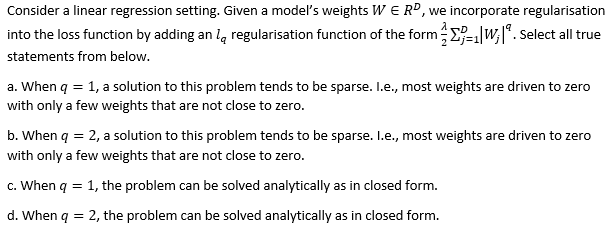Consider a linear regression setting. Given a model's weights W E Rº, we incorporate regularisation into the loss function by adding an lą regularisation function of the formE-1|W,|*. Select all true statements from below. a. When q = 1, a solution to this problem tends to be sparse. I.e., most weights are driven to zero with only a few weights that are not close to zero. b. When q = 2, a solution to this problem tends to be sparse. I.e., most weights are driven to zero with only a few weights that are not close to zero. c. When q = 1, the problem can be solved analytically as in closed form. d. When q = 2, the problem can be solved analytically as in closed form.
Consider a linear regression setting. Given a model's weights W E Rº, we incorporate regularisation into the loss function by adding an lą regularisation function of the formE-1|W,|*. Select all true statements from below. a. When q = 1, a solution to this problem tends to be sparse. I.e., most weights are driven to zero with only a few weights that are not close to zero. b. When q = 2, a solution to this problem tends to be sparse. I.e., most weights are driven to zero with only a few weights that are not close to zero. c. When q = 1, the problem can be solved analytically as in closed form. d. When q = 2, the problem can be solved analytically as in closed form.
Operations Research : Applications and Algorithms
4th Edition
ISBN:9780534380588
Author:Wayne L. Winston
Publisher:Wayne L. Winston
Chapter24: Forecasting Models
Section: Chapter Questions
Problem 10RP
Related questions
Question

Transcribed Image Text:Consider a linear regression setting. Given a model's weights W E RD, we incorporate regularisation
into the loss function by adding an la regularisation function of the form-W;|*. Select all true
statements from below.
a. When q = 1, a solution to this problem tends to be sparse. I.e., most weights are driven to zero
with only a few weights that are not close to zero.
b. When q = 2, a solution to this problem tends to be sparse. I.e., most weights are driven to zero
with only a few weights that are not close to zero.
c. When q = 1, the problem can be solved analytically as in closed form.
d. When q = 2, the problem can be solved analytically as in closed form.
Expert Solution
This question has been solved!
Explore an expertly crafted, step-by-step solution for a thorough understanding of key concepts.
This is a popular solution!
Trending now
This is a popular solution!
Step by step
Solved in 2 steps with 1 images

Knowledge Booster
Learn more about
Need a deep-dive on the concept behind this application? Look no further. Learn more about this topic, computer-science and related others by exploring similar questions and additional content below.Recommended textbooks for you

Operations Research : Applications and Algorithms
Computer Science
ISBN:
9780534380588
Author:
Wayne L. Winston
Publisher:
Brooks Cole

Operations Research : Applications and Algorithms
Computer Science
ISBN:
9780534380588
Author:
Wayne L. Winston
Publisher:
Brooks Cole